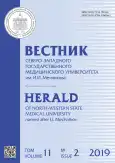Electroencephalographic arousal pattern in severe alcohol poisoning
- Authors: Aleksandrov M.V.1,2, Povalyukhina E.S.1,3, Alexandrova T.V.3, Ivanov L.B.4, Chernyi V.S.5
-
Affiliations:
- Russian Neurosurgery Research Institute named after prof. A.L. Polenov (branch of the Almazov National Medical Research Center)
- Institute of toxicology of Federal Medical-Biological Agency
- Dzhanelidze Research Institute of Emergency Medicine
- Moscow City Clinical Hospital № 9 of G.N. Speransky
- Military Medical Academy named after S.M. Kirov
- Issue: Vol 11, No 2 (2019)
- Pages: 5-12
- Section: Original study article
- URL: https://journals.rcsi.science/vszgmu/article/view/11197
- DOI: https://doi.org/10.17816/mechnikov20191125-12
- ID: 11197
Cite item
Full Text
Abstract
Parameters dynamics of brain bioelectric activity of 50 patients in alcoholic coma are considered. Patients underwent continuous EEG monitoring from the end of the basic resuscitation to the apparent recovery of consciousness (awakening). The average registration time was 4.5 hours. EEG was recorded in standard derivations using the 10–20 system. The amplitude-frequency indices of spontaneous activity and reactivity are analyzed. Electroencephalographic correlates of cerebral insufficiency in comatose states are distinguished by pronounced polymorphism and high individual variability. Considering these features, “dynamic” parameters should be used as prognostic criteria: spontaneity and variability of the pattern, reactivity during stimulation. The increase in the frequency of bioelectric activity, desynchronization with external stimuli may indicate the beginning of the process of recovery of consciousness. Electrophysiological criteria for awakening, developed in this work on the example of alcoholic coma, can be mostly applicable to unconscious states caused by other etiological factors: trauma, hypoxia, vascular failure.
Full Text
##article.viewOnOriginalSite##About the authors
Mikhail V. Aleksandrov
Russian Neurosurgery Research Institute named after prof. A.L. Polenov (branch of the Almazov National Medical Research Center); Institute of toxicology of Federal Medical-Biological Agency
Email: mdoktor@yandex.ru
Russian Federation, St.Petersburg
Ekaterina S. Povalyukhina
Russian Neurosurgery Research Institute named after prof. A.L. Polenov (branch of the Almazov National Medical Research Center); Dzhanelidze Research Institute of Emergency Medicine
Email: mdoktor@yandex.ru
Russian Federation, St.Petersburg
Tatyana V. Alexandrova
Dzhanelidze Research Institute of Emergency Medicine
Email: tata-al@yandex.ru
Russian Federation, St.Petersburg
Lev B. Ivanov
Moscow City Clinical Hospital № 9 of G.N. Speransky
Email: mdoktor@yandex.ru
Russian Federation, Moscow
Valery S. Chernyi
Military Medical Academy named after S.M. Kirov
Author for correspondence.
Email: 9297911@list.ru
Russian Federation, St.Petersburg
References
- Белкин А.А., Зислин Б.Д., Аврамченко А.А. и др. Синдром острой церебральной недостаточности как концепция нейрореаниматологии // Анестезиология и реаниматология. – 2008. – № 2. – С. 4–8. [Belkin AA, Zislin BD, Avramchenko AA et al. Acute cerebral insufficiency syndrome as a concept of neu-roreanimatology. Russian Journal of Anаеsthesiology and Reanimatology. 2008; 2: 4–8. (In Russ.)].
- Лужников Е.А., Леженина Н.Ф., Гольдфарб Ю.С. и др. Особенности формирования и течения токсико-гипоксической энцефалопатии при острых отравлениях веществами нейротоксического действия // Анестезиология и реаниматология. – 2005. – № 6. – С. 4–8. [Luzhniki EA, Lezhenina NF, Goldfarb YuS et al. The specific features of the development and course of toxicohypoxic encephalopathy in acute poisoning by neurotoxic agents. Russian Journal of Anаеsthesiology and Reanimatology. 2005; 6: 4–8. (In Russ.)].
- Александров М.В. Влияние психотропных средств на биоэлектрическую активность головного мозга // Сибирское медицинское обозрение. – 2017. – № 1 (103). – С. 85–88. [Aleksandrov MV. Vliyanie psihotropnyh sredstv na bioelektricheskuyu aktivnost golovnogo mozga. Sibirskoe medicinskoe obozrenie. 2017; 1(103): 85–88. (In Russ.)]. doi: 10.20333/2500136-2017-1-85-88.
- Пшенникова Г.М., Петрова М.А. Электроэнцефалография при коматозных состояниях у детей // Международный научно-исследовательский журнал. – 2012. – № 5 (5). – Ч. 3. – С. 68–69. [Pshennikova GM, Petrova MA. An electroencephalography at comas at children. The International research magazine. 2012; 5-3 (5): 68–69 (In Russ.)]. URL: https: // research-journal.org/medical/elektroencefalografiya-pri-komatoznyx-sostoyaniyax-u-detej/ (дата обращения: 21.09.2018).
- Александров М.В., Александрова Т.В., Повалюхина Е.С. Электроэнцефалографический мониторинг в отделении реанимации и интенсивной терапии // Вестник Северо-Западного государственного медицинского университета им. И.И. Мечникова. – 2018. – T. 10. – № 3. – С. 81–90. [Alexandrov MV, Alexandrova TV, Povalyukhin ES. Electroentsephalografic monitoring in the intensive care unit. Herald of the Northwestern State Medical University named after I.I. Mechnikov. 2018; 10(3): 81–90. (In Russ.)]. doi: 10.17816/mechnikov201810381-90.
- Altindag E, Okudan ZV, Оzkan ST, et al. Electroencephalographic patterns recorded by continuous EEG monitoring in patients with change of consciousness in the neurological intensive care unit. Archives of Neuropsychiatry. 2016. doi: 10.5152/npa.2016.14822.
- Chong DJ, Hirsch LJ. Which EEG patterns warrant treatment in the critically ill? Reviewing the evidence for treatment of periodic epileptiform discharges and related patterns. J Clin Neurophysiol. 2005;22:79–91.
- Herta J, Koren J, Fürbass F, et al. Prospective assessment and validation of rhythmic and periodic pattern detection in NeuroTrend: a new approach for screening continuous EEG in the intensive care unit. Epilepsy Behav. 2015; 49: 273–9.
- Pelayo R, Dement WC. History of sleep physiology and medicine. In Principles and Practice of Sleep Medicine, 6-th ed. Kryger M, Roth T, Dement WC, Eds. Philadelphia, PA: Elsevier. 2016, pp 3–14.
- Roshdy A, Saleh AS. Salzburg criteria: Can we extend validation to critical care? Lancet Neurol. 2017;16:25.
- Fürbass F, Hartmann MM, Halford JJ, et al. Automatic detection of rhythmic and periodic patterns in critical care EEG based on American Clinical Neurophysiology Society (ACNS) standardized terminology. Neurophysiol Clin. 2015a; 45: 203–13.
- Куценко С.А. Основы токсикологии. – СПб.: Фолиант, 2005. – 720 с. [Kutsenko SA. Fundamentals of toxicology. SPb.: Foliant; 2005. 720 р. (In Russ.)].
- Лужников Е.А., Гольдфарб Ю.С. Детоксикационная терапия при критических состояниях токсической этиологии // Общая реаниматология. – 2006. – Т. 2. – № 6. – С. 153–162. [Luzhnikov Y.A., Goldfarb Y.S. Detoxification Therapy in Critical States of Toxic Etiology. General Reanimatology. 2006; 2(6): 153–162. (In Russ.)]. doi: 10.15360/1813-9779-2006-6-153-162.
- Александров М.В., Иванов Л.Б., Лытаев С.А. и др. Электроэнцефалография. – СПб.: Стратегия будущего, 2018. – 178 с. [Aleksandrov MV, Ivanov LB, Lytaev SA, et al. Elektroentsefalografiya. Saint-Petersburg: Strategiya budushchego; 2018. 178 p. (In Russ.)].
Supplementary files











